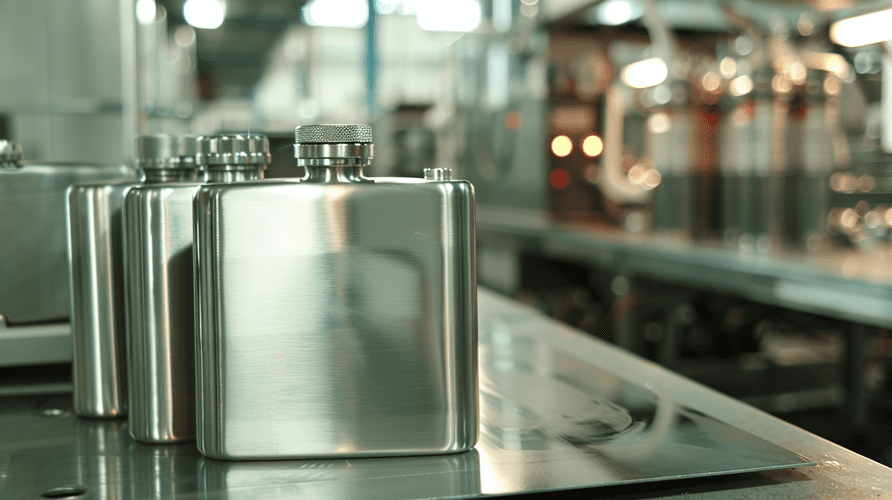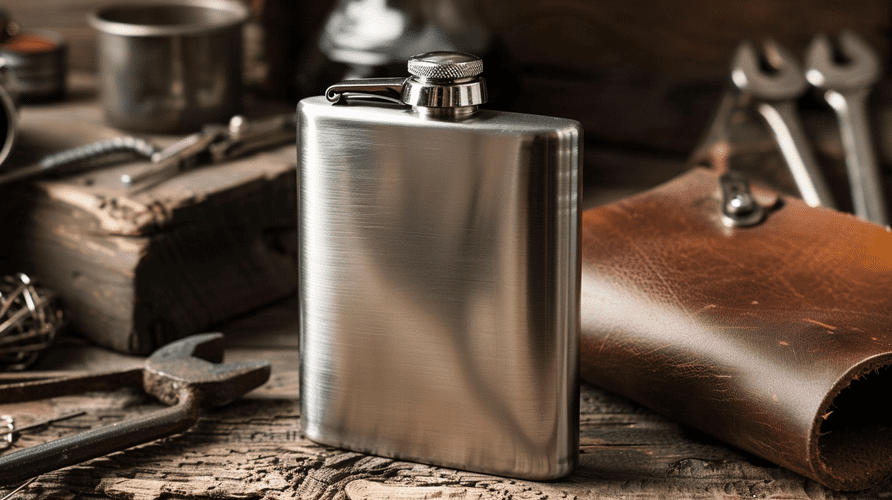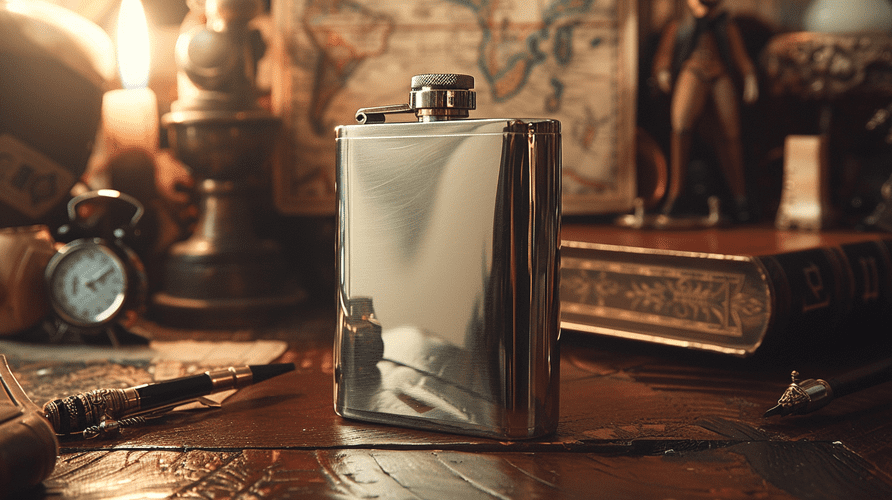Choosing hip flasks for your brand can be confusing. A bad choice can damage your reputation and cost you money. I will help you find the perfect flasks for your business.
The best choice for business is a flask made from food-grade 304 stainless steel. You must look for high-quality features like clean laser welding and a guaranteed leak-proof cap. Finding a reliable supplier with strong quality control is more important than focusing on a specific factory brand.

I've been in this business for a long time, and I talk to buyers every day. Many of them are just like you. They are looking for a quality product that will make their customers happy and their business profitable. Over the years, I've noticed the same questions come up again and again. These are the critical questions that separate a smart purchase from a costly mistake. Let's walk through these questions together. I will share my insights from years of manufacturing and exporting hip flasks. This will help you make a confident decision for your business.
Is Pewter or Stainless Steel Better for a Hip Flask?
Are you trying to decide between traditional pewter and modern stainless steel? Choosing the wrong material can lead to unhappy customers and lower profits. Let's compare them for your business needs.
For any B2B purchase, 304 stainless steel is the clear winner. It's much more durable, completely safe for all drinks, and significantly more cost-effective for wholesale orders. Stainless steel offers the best balance of quality, safety, and value for your brand.

When you're importing products to rebrand and sell, every detail matters. The material of your hip flask is one of the most important choices you'll make. It affects durability, customer safety, and your profit margin. While pewter has a classic, heavy feel that some associate with luxury, it presents several problems for a modern business. Stainless steel, specifically grade 304, solves these problems. I once worked with a client who initially wanted pewter for its "premium" feel. After we reviewed the real-world implications for his business model, he quickly realized stainless steel was the smarter, safer, and more profitable path.
Durability and Maintenance
Pewter is a soft metal. It looks nice, but it dents and scratches very easily. This can lead to customer complaints and returns. Stainless steel is incredibly tough and resists impacts. It's also simple to care for. You can clean it easily, and it won't tarnish. This low-maintenance quality is a great selling point for your customers.
Safety and Taste
This is a critical point. Food-grade 304 stainless steel is inert. This means it does not react with alcohol or other liquids. It will never add a metallic taste to the drink. Modern pewter is lead-free, but it can still react with acidic drinks over time. With 304 stainless steel, you guarantee a safe, pure taste for your customers, which protects their health and your brand's reputation.
Cost and Scalability
For a business owner, this is often the deciding factor. The cost to produce a pewter flask is much higher than a stainless steel one. This means your purchase price will be higher, and your profit margin will be smaller. Stainless steel is very cost-effective to manufacture in large quantities. This allows you to get a high-quality product at a competitive price, giving you more flexibility in your pricing strategy.
| Feature | 304 Stainless Steel | Pewter |
|---|---|---|
| Durability | High (Resists dents/scratches) | Low (Soft, dents easily) |
| Corrosion Resistance | Excellent | Good |
| Food Safety | Excellent (Inert) | Good (Modern is lead-free) |
| Taste Neutrality | Yes | Can sometimes react |
| Cost (Wholesale) | Low | High |
| Business Viability | Excellent | Niche / Risky |
Which Stainless Steel Flask is Best?
Advertisements are full of flasks all claiming to be "the best." It's hard to know which product is truly high-quality. I'll show you the specific features that really matter.
The best flask is made from certified 18/8 (304) stainless steel. It must have smooth, strong laser-welded seams to prevent leaks. It also needs a high-quality, leak-proof cap with a food-grade silicone seal1. The inside should be perfectly smooth to ensure a pure taste.

Not all stainless steel flasks are created equal. Two flasks can look similar online, but in person, the difference in quality can be huge. As a manufacturer, I see these differences on the factory floor every day. The best flasks aren't the result of one single feature, but a combination of the right material, precise construction, and attention to small but critical details. When you are sourcing products for your brand, you need to know exactly what to look for. Let's break down the three most important components of a truly great stainless steel hip flask.
The Steel Itself: Grade 304 (18/8)
The foundation of any great flask is the steel. You must insist on food-grade 304 stainless steel, which is also called 18/8 steel. This name comes from its composition: 18% chromium and 8% nickel. The chromium provides incredible rust and corrosion resistance, and the nickel adds to its durability. Cheaper flasks might use lower-grade steel, like 201, which can rust over time and is not as safe for contact with food and drinks. Always ask your supplier for material test reports to verify you are getting genuine 304 stainless steel that meets international standards like FDA and LFGB.
The Construction: Clean Laser Welding
The body of a flask is typically made from two pieces of steel welded together. The quality of this weld is critical for preventing leaks. The best method is laser welding2. Laser welds are extremely clean, precise, and strong. They create a seamless bond that is almost invisible. Older or cheaper methods can leave messy seams that can weaken over time and trap bacteria. When you inspect a sample, run your finger over the side. A well-made flask will feel perfectly smooth. A poorly made one will have a noticeable and sometimes sharp edge.
The Cap and Seal: Your Leak-Proof Guarantee
The cap is the most common point of failure for a hip flask. A leaking flask is a disaster for your customer and your brand. A quality cap will screw on smoothly and tightly. Look for a seal inside the cap made from food-grade silicone. Silicone creates a perfect seal, is durable, and does not contain harmful chemicals like BPA. Avoid flasks with cheap, hard plastic seals, as they can crack and fail. Many good flasks also have a "captive cap," which is an arm that attaches the cap to the flask so it can't be lost. This is a small feature that customers really appreciate.
How to Know a Good Stainless Flask?
You have a sample flask in your hands. It looks good on the surface, but how can you be certain of its quality? Let me give you a simple checklist for inspection.
First, ask the supplier for material certification to prove it's 304 steel. Then, look closely at the welds; they must be smooth. Test the cap by filling the flask with water and shaking it—it must not leak. Finally, the inside should be clean and have no metal smell.

As a buyer, you can't just trust the product description. You need to know how to inspect a sample yourself. I've seen buyers from major companies do these exact tests when they visit my factory. These simple checks can save you from investing in a low-quality product that will cause you problems later. Think of yourself as the first line of quality control for your business. A few minutes of careful inspection can tell you almost everything you need to know about the flask's quality and the supplier's standards. This process builds confidence in what you're buying.
Visual Inspection: What to Look For
Hold the flask up to the light. Look at the surface finish. Is it smooth and even, or are there scratches and imperfections? Pay close attention to the seams on the side. A laser-welded flask will have a very faint, clean line. A poorly welded flask will have a thicker, messier seam. Unscrew the cap and look at the threads on both the cap and the flask. They should be clean-cut and smooth. Poorly made threads can be sharp and will wear out quickly, leading to leaks. Look inside the flask with a small light. The interior should be bright and smooth, a sign of proper finishing (passivation or electropolishing) that prevents a metallic taste.
Physical Tests: Simple but Effective
These tests reveal the true quality.
- The Leak Test: This is the most important test. Fill the flask with water, screw the cap on tightly, and shake it vigorously. Turn it upside down and leave it on a paper towel for a few minutes. There should be absolutely no drips.
- The Smell Test: A well-made flask from 304 stainless steel will have no smell. If you smell metal, chemicals, or oil, it's a major red flag. This could mean the wrong material was used or it wasn't cleaned properly after manufacturing.
- The Weight Test: Hold the flask in your hand. Does it have a solid, sturdy feel? Or does it feel light and flimsy? A good flask has some heft to it, which indicates a proper wall thickness. Cheaper flasks use thinner steel to save costs, but they will dent easily.
Documentation Check: Trust but Verify
Finally, don't just take the salesperson's word for it. This is a common pain point I hear about from buyers like Mark in Canada, who has been burned by fraudulent certificates before. Ask for the paperwork. A reliable supplier will have no problem providing you with copies of their material test reports for the 304 stainless steel. They should also provide compliance certificates like FDA, LFGB, or Prop 65, depending on your target market. This documentation is your proof that the product is safe and legally compliant for sale.
Which Company Flask is Best?
It is overwhelming to search for the "best" flask company. Choosing the wrong partner can cost you thousands in lost sales and delayed shipments. Focus on finding a great supplier, not just a brand name.
The "best" company isn't a famous brand; it's a manufacturing partner you can trust. They must have excellent quality control, clear communication, and the ability to customize products to meet your specific business needs and deadlines.

After more than a decade in this industry, I can tell you with certainty: the success of your product line depends more on your relationship with your supplier than on the product itself. A great product from an unreliable supplier is a recipe for disaster. I've seen buyers frustrated by language barriers, missed deadlines that caused them to miss peak selling seasons, and inconsistent quality from one order to the next. The "best" company is the one that works with you as a partner to prevent these problems.
Quality Control and Consistency
When you order 5,000 flasks, you need to know that the 5,000th flask is the same quality as the first sample you approved. This is where a supplier's Quality Control (QC) system is vital. Ask them about their process. Do they inspect raw materials when they arrive? Do they have inspectors on the production line? Do they perform a final inspection on a percentage of the finished goods before shipping? A great partner will have a multi-stage QC process and will be happy to share the details with you. This ensures consistency and dramatically reduces your risk of receiving defective products.
Communication and Support
This is perhaps the biggest pain point for importers. Inefficient communication is frustrating and costly. You need a dedicated sales representative who speaks your language fluently and understands your needs. They should be responsive, providing clear answers and regular updates on your production schedule. When I hire my sales staff, I look for people who can not only sell but also solve problems. A great partner doesn't disappear after you place the order. They are there to help with logistics, documentation, and any issues that arise until the shipment is safely in your warehouse.
Customization and Compliance Capability
Your business is unique. You need a supplier who can adapt to your needs. This is especially true for hip flasks, which are popular for gifting and promotions. Can the supplier handle your specific logo application, whether it's laser engraving, screen printing, or something else? Can they provide custom colors or unique packaging? Beyond customization, they must understand compliance for your market. A supplier who regularly exports to America and Europe will already be familiar with FDA and LFGB standards. They will know what testing is required and can provide the correct documentation, making your import process smooth and trouble-free.
Can You Take a Hip Flask on a Plane?
Your customers may have questions about traveling with their new flask. Giving them the wrong information could cause them big problems at airport security. Here is the simple, correct answer.
Yes, you can bring a stainless steel hip flask3 on an airplane. For carry-on bags, it must either be empty or contain less than 100ml (3.4oz) of liquid. For checked luggage, there are generally no restrictions on filling it.

This might seem like a small detail, but for your end customer, it's very practical information. As a business owner, providing this kind of helpful tip on your product listing, packaging, or website can improve the customer experience. It shows you've thought about how they will use the product in the real world. It builds trust and can be a small factor that makes a customer choose your brand over a competitor's. It's a simple way to add value beyond the physical product itself.
The Rules for Carry-On Luggage
Almost every country's airport security has a rule about liquids in carry-on bags. In the US, it's the TSA's 3-1-1 rule. This means liquids must be in containers of 3.4 ounces (100 milliliters) or less, and all containers must fit in one clear, quart-sized bag. A standard 6oz or 8oz hip flask is larger than this allowance. Therefore, if a customer wants to carry their flask in their cabin baggage, they must make sure it is completely empty. The flask itself is not a problem; it's the liquid inside that's restricted. Advising customers to empty their flask before heading to the airport is the safest and simplest recommendation.
The Rules for Checked Luggage
The rules for liquids in checked luggage are much more relaxed. A customer can fill their hip flask and pack it in their checked bag without any issues. The pressure changes in the cargo hold are not a concern for a well-made stainless steel flask. However, it's always a good idea to recommend that they ensure the cap is screwed on very tightly. For extra peace of mind, they could place the flask in a sealed plastic bag. This prevents any potential leaks from spilling onto their clothes, just in case the bag is handled roughly by baggage handlers.
Why This Information Helps Your Business
Think about the customer journey. Someone buys your flask as a gift for a friend who travels. Including a small card or a note on the box that says "Travel Tip: Empty this flask for carry-on luggage" is incredibly helpful. It anticipates a customer's question and provides a solution. This small touch elevates your brand from just a product seller to a thoughtful resource. It's a low-cost, high-impact way to improve customer satisfaction and encourage positive reviews.
Conclusion
Choosing the right flask is easy with the right knowledge. Focus on 304 steel, leak-proof construction, and, most importantly, a reliable supplier. This focus ensures profit and a happy customer.
-
Learn why food-grade silicone seals are essential for leak-proof flasks and safe drinking. This link offers detailed information. ↩
-
Discover how laser welding enhances the durability and quality of products like flasks. This resource will provide valuable insights. ↩
-
Discover the advantages of stainless steel hip flasks, including durability and safety for travel. This resource can enhance your travel experience. ↩

